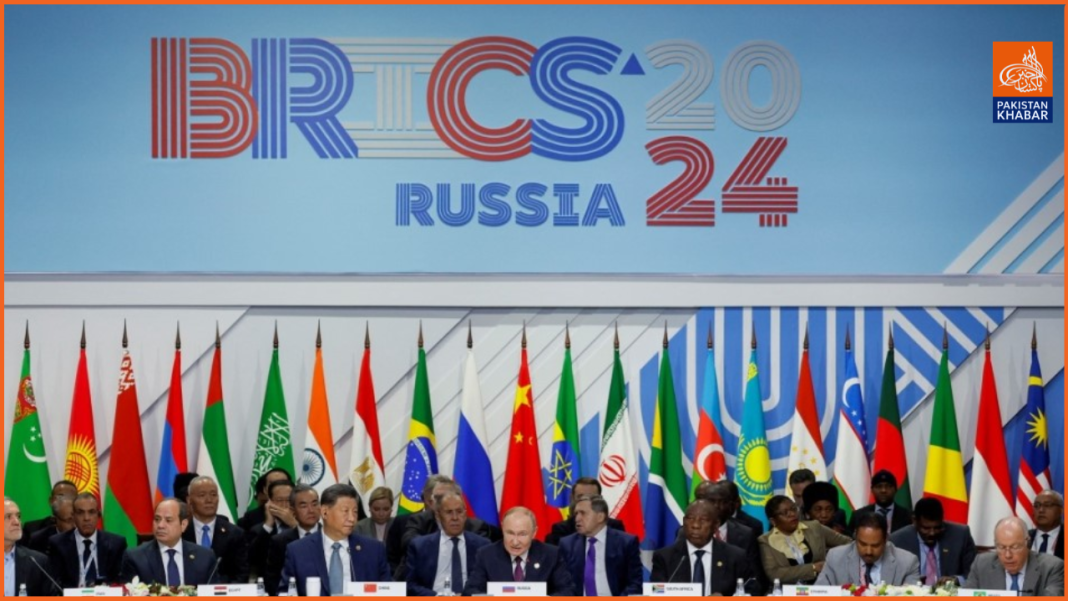The 16th BRICS summit was held in Russian city Kazan from October 22 to 24. The BRICS Summit was attended by the leaders and delegations from 35 countries including Chinese president Xi Jinping and Indian Prime Minister Modi. The 35 page long Kazan Declaration that was agreed at this year’s Summit, is the most detailed and ambitious yet since the BRICS was formed 15 years ago. The Kazan Declaration includes many important statements on international issues like Gaza war, Ukraine war, economic sanctions and many economic ini
tiatives.
The Kazan Declaration condemned Israel’s brutal actions against the Palestinians and Lebanon and called for an immediate ceasefire in the region, recognition of the Palestinian state and concrete steps towards a two state solution. As an indication of the BRICS solidarity with the Palestinians, Mahmoud Abbas, the President of the Palestinian Authority was invited to and present at the BRICS Summit.
The Kazan Declaration also called for democratisation of the United Nations. Not just in the membership of the Security Council, but in the makeup of its Secretariat and its operation as a whole. The Kazan Declaration includes the proposals to democratise the World Bank and the International Monetary Fund.
The decisions of the Summit showed that the BRICS is no longer a platform for vague diplomatic statements but is seriously getting down to coordinating its member economies. The creation of the BRICS Trading System and a series of Commodity Exchanges will have a profound impact on international trade and will sideline the traditional commodity exchanges located in the US and the UK. This is already having a serious effect on US agriculture and metals trading.
Meanwhile, while there are no immediate plans to create an alternative currency, the creation of various systems for financial payments in local currencies between the BRICS countries and other methods can only reduce transaction costs and accelerate the decline of the Dollar. Already, the amount of international trade being conducted in dollars, and the amount of dollars being held in central bank reserves is falling.
The Kazan summit agrees to include more developing countries in the BRICS New Development Bank, increase its capital and lending, and raise the proportion of transactions made in local currencies.
A BRICS investment platform is being created to make applications for loans easier and more transparent. This will be accompanied by a new BRICS Investment Arbitration Centre in order to improve the protection of mutual investments and develop a convention for settling investment disputes.
Many Western commentators dismiss the BRICS as just an economic bloc. But they forget that it is economic strength that has always been the underlying basis of geopolitical power, military power etc. It is the past economic weakness of the peoples of Africa, Latin America and Asia that has allowed them to be colonised and exploited. It is to end this inequality of wealth and power that the BRICS has been formed. And it is why the BRICS are mainly focusing on economic questions and seeking to integrate their economic development efforts.
Indeed, this drive for economic integration is what marks the BRICS out from all the previous efforts of the developing world to overcome its poverty and weakness. The attempt to use the United Nations to this end has so far clearly failed.
The economic power of the neo-imperialist countries in the G7 has allowed them to ignore the wishes and needs of the global majority. With only 10% of the world’s population they believe they have the right to rule over the rest of us. When it comes to international relations all the talk of democracy by the West conveniently disappears.
Another key decision of this BRICS Summit was how to expand the membership of BRICS. This is a relatively difficult subject given the experience since the last Summit in South Africa which agreed to invite six countries to join. As it happens, two of the six have not yet joined.
To cater for these various situations, the BRICS has sensibly agreed to create an interim stage of membership which they are calling a “Partner State” status. This will allow many countries to associate themselves with BRICS and participate in its activities without having to go all the way and become full members. This ‘halfway house’ can involve many more countries in the various BRICS initiatives and build up relationships which over time will likely lead to full membership.
Consultations with 13 countries have now been opened for them to become “Partner States”. These new potential “Partner States” include:
Turkiye, Indonesia, Algeria, Belarus, Cuba, Bolivia, Malaysia, Uzbekistan, Kazakhstan, Thailand, Vietnam, Nigeria, and Uganda. There are estimated to be another 33 countries who have expressed an interest in joining.
It was announced during the summit that BRICS members now represent 36.7 percent of global GDP in terms of purchasing power parity. While the share of the G7 countries is only 30 percent.
Moreover, it was noted that BRICS countries are growing faster than the global average at around 3.8 percent in 2024–2025, while global GDP is estimated to increase by 3.2–3.3 percent. When you look only at the G7 countries both Europe and Japan are effectively in Recession.
The combination of China, Russia, the newly emerging economies and the remaining countries of the developing world are the driving force behind the rise of the BRICS. Together, they are seeking to create a fairer world order that will allow them to end poverty and achieve prosperity.
To this end, the current and future members of BRICS are looking to industrialise their societies. Accordingly, the BRICS has launched a ‘Partnership for the New Industrial Revolution’ – this is a guiding platform to help industrialise BRICS members using the latest technologies.
To achieve this industrialisation the BRICS understands the need to coordinate the economic activities of its membership and gain the advantages of scale. To put this into practice, the BRICS is creating a whole layer of platforms and coordinating mechanisms.




